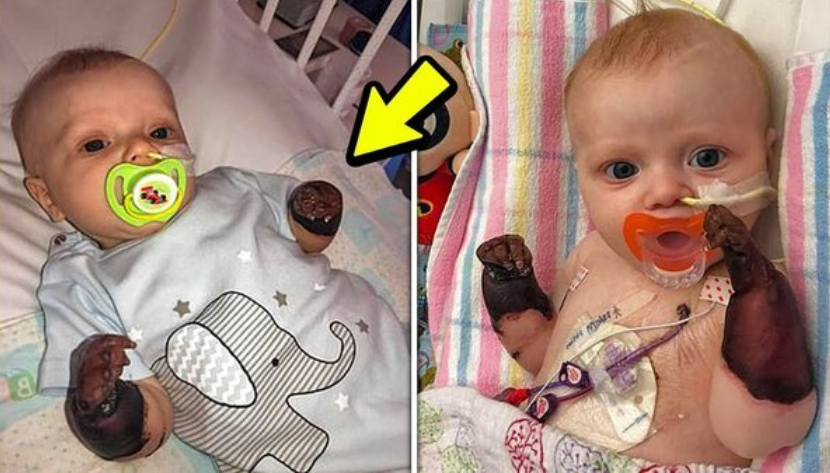Inspirational
Baby Started To Lose His Hands. Mom Takes a Closer Look And Runs To The Doctor

During their vacation, a newborn baby broke out in a skin rash, and the doctors aren’t sure how to cure it. Now, he’s facing limb amputation because the doctors don’t know what to do. Parents Sydney and Gemma were worried about their first child when they sensed something was wrong.
Their four-month-old son was discharged from the hospital after being diagnosed with a probable UTI (urinary tract infection). In the process of diagnosing the condition, the doctor noticed that he was suffering from a rash, which may result in the need to amputate his limbs due to the disease cutting off his circulation. Several blood clots produced by a rare condition in a newborn who was sent home from the hospital for a UTI could result in the loss of his arms if the disease cuts off his circulation.
After returning from a family vacation of more than four weeks, Sydney, Roger, and Matthew Courier realized something was wrong with their four-month-old son, Logan, as he contracted a rare disease that baffled their medical team.
Now they face the prospect of their only son losing both his hands as well as his left leg if the disease continues, according to Courier, who spoke to Daily Mail Australia. “I wouldn’t wish this on my worst enemy because we have no idea what’s going on, and the doctors where we live have no idea how the diseases interfere with each other. I would never want someone to be a medical mystery,” says the author.
Logan’s health is currently unknown, and the medical team believes he has a combination of Kawasaki disease and rheumatoid arthritis, but they are not yet sure of the exact diagnosis. They believe the disorders may have somehow worked together to cause blood clots throughout Logan’s heart, lungs, and body, ultimately leading to reduced blood flow to his extremities.
Courier revealed that Logan will lose his hands and perhaps both arms below the elbows as a result of the accident and his illness. His left leg has also been affected from the knee down, and they are unsure to what extent the doctors will hold his arms to see what is still alive. They must first wait for the dead skin to peel off.
The couple first noticed a rash during a family vacation on the Gold Coast, after which Logan became angry and started vomiting. He was taken to the emergency department at Gold Coast University Hospital, where he was diagnosed with a UTI and prescribed antibiotics to go home.
When his condition deteriorated and his hand began to turn purple, he was taken back to the hospital, where doctors discovered his new ailment. This was the first time Courier had seen anything like this. Eventually, Logan was flown from the hospital in Sydney to be closer to his family.
Logan’s parents have created a GoFundMe campaign to help with the cost of prosthetics and Logan’s future medical treatment. This is their first child, and though they have both taken time off work, Gemma is on maternity leave, and Mr. Courier’s paid leave is starting to deplete their bank accounts.
With her maternity leave over, Courier intends to work as a bricklayer to continue supporting their small family. He stated that the whole situation has been difficult, but they are trying to take things one day at a time. Mr. Courier admitted that some days are better than others, and they find joy in Logan’s better days, though even the smallest things like coughing or sneezing can cause them to become alarmed, feeling that something else might be wrong with him.
Kawasaki disease, also known as Kawasaki syndrome, is an acute febrile illness with no known cause that usually affects children under five years of age. It is caused by an airborne virus, and its symptoms include fever, rash, swelling of hands and feet, irritation and redness of the whites of the eyes, swollen lymph nodes in the neck, irritation and swelling of the mouth, lips, and throat.
The disease is the most common cause of acquired heart disease in the United States, leading to coronary artery dilations and aneurysms. Current treatment includes intravenous immunoglobulin and aspirin, which have been shown to significantly slow the progression of coronary artery abnormalities. Kawasaki disease is found worldwide, with the highest prevalence in Japan, and mainly affects children under five years of age. It can be seasonal, peaking in the winter and spring, and epidemics affecting an entire community have occasionally been reported.
The CDC has maintained a surveillance system since 1976 to track and understand Kawasaki disease in the United States, using hospital discharge databases and a passive surveillance system. Special studies are conducted to better understand the incidence and epidemiology of the disease in the US.
The incidence of Kawasaki disease in the continental US is estimated to range from approximately nine to 20 cases per 1000 children under the age of five years. In 2006, there were 5440 hospitalizations for the disease, and in 2016, among children under 18 years of age in the US, 3935 of them were under five years old, resulting in a hospitalization rate of 19.8 per 1000 children in that age group.
A case of Kawasaki disease is defined as an illness in a patient who has had a fever for five days or more, fever until the date of intravenous immunoglobulin administration before the fifth day, and at least four of the five following clinical signs: rash, lymphadenopathy of the cervical region, conjunctival fluid emission on both sides, changes in the oral lining, and changes in the extremities of the periphery.
In patients with this disease who do not present symptoms and respond to the description of the previous case, but who do present symptoms such as fever and coronary artery anomalies, they are characterized by a Pica or incomplete idiopathic disease.
